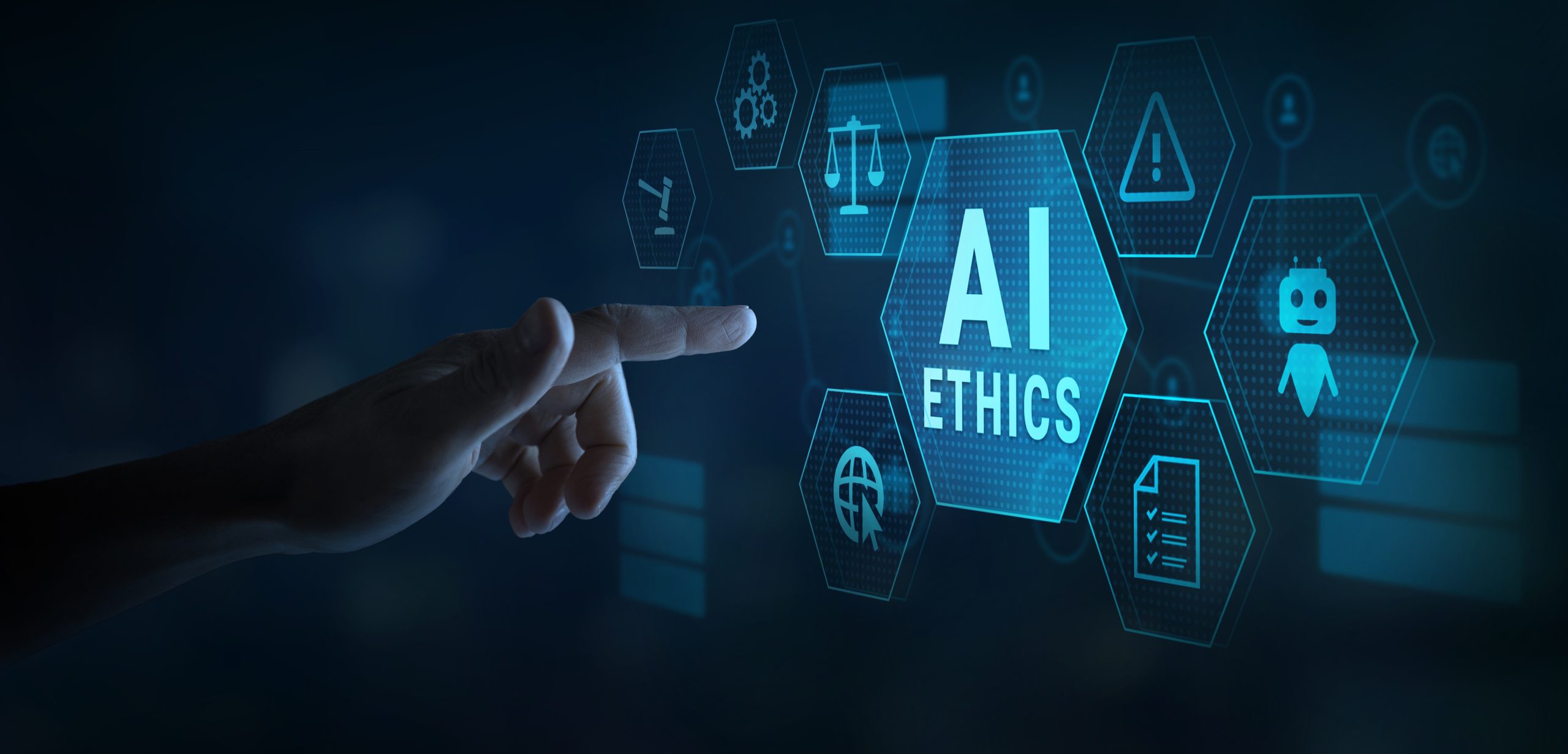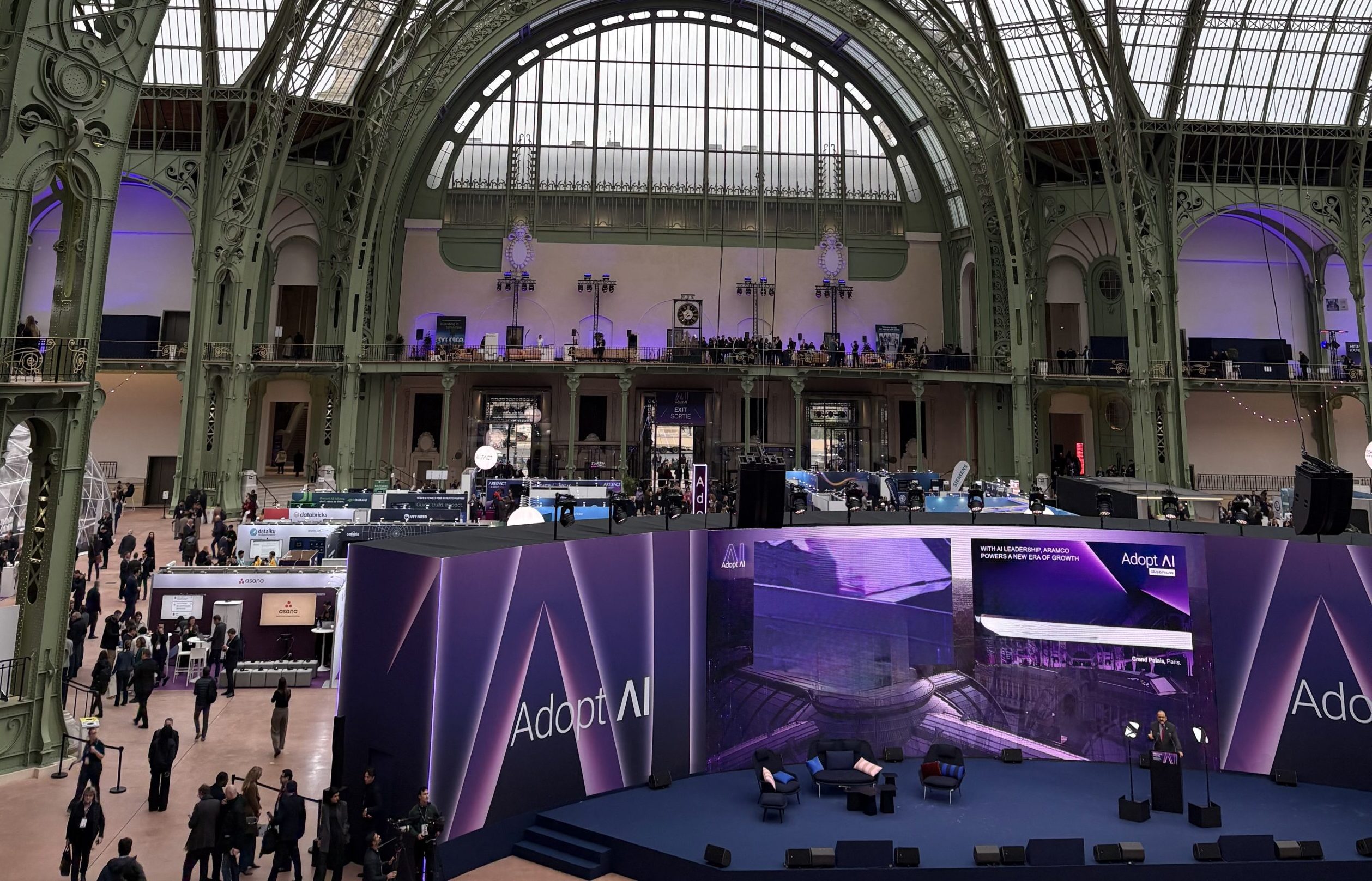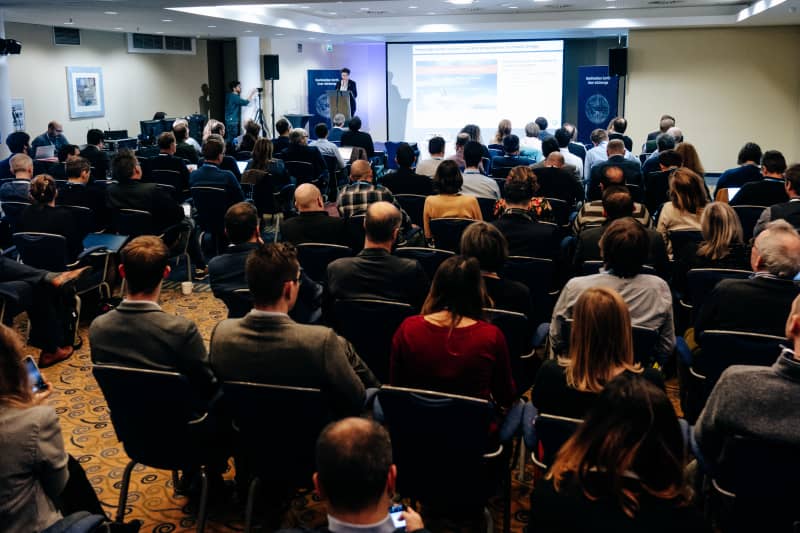
The objective of the User eXchange series is to encourage participation and dialogue between the different actors involved in DestinE and to create a space for discussion, progress and new opportunities.
On the 13-14 November 2023, the 2nd Destination Earth User eXchange meeting was held in Bonn, Germany. The event was hosted by the European Centre for Medium-Range Weather Forecasts (ECMWF) and co-organised with the European Space Agency (ESA) and the European Organisation for the Exploitation of Meteorological Satellites (EUMETSAT).
More than 200 participants gathered onsite, with a further 231 registered online, all keen to discover the considerable progress made in the ambitious European Union initiative to build a digital twin of Earth.
The European Commission was represented by members of DG CNECT; Gustav Kalbe Acting Director Digital Excellence and Science Infrastructures, who spoke during the opening, and Charalampos Tsitlakidis, Team Leader for Destination Earth who closed the event. Both officials highlighted the progress made in recent months, since the first exchange meeting in February 2023. The European Environment Agency Executive Director Leena Ylä-Mononen commented on the high expectations once this new information system will be available, providing a breakthrough in terms of Earth system data.
Ylä-Mononen said that DestinE and the digital twins make a link in the twin transition, Green and Digital, for a better societal preparedness. DestinE could contribute to model the risks and the response to the challenges of climate change providing insights on “where the EU needs to invest and help the regional level and the users to make better decisions, these are the areas where our agency will need to work closely with Desination Earth in the future.”
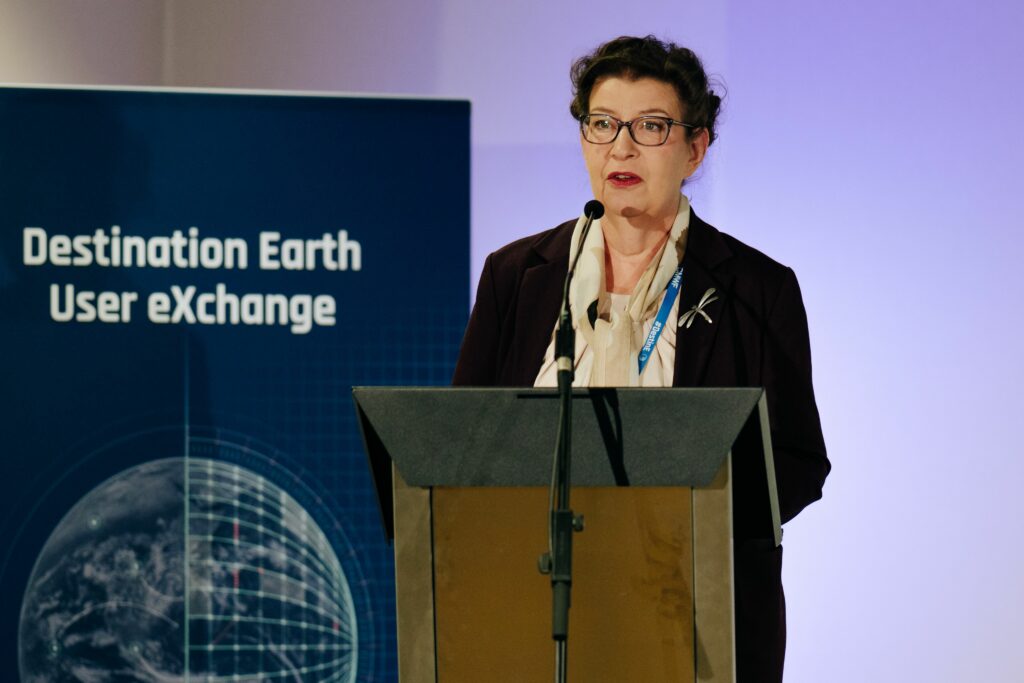
In her welcoming speech, Director General of ECMWF Florence Rabier celebrated the initiative, presenting DestinE and ECMWF digital twins as a system that will take decision-making capabilities to the next level. Rabier highlighted how DestinE is unprecedented in terms of detail, quality and interactivity and how European digital capabilities in numerical simulations, supercomputing, digital technologies and artificial intelligence play a crucial role.
Progress updates
Director for Destination Earth at ECMWF Irina Sandu detailed the objectives of the initiative and progress of the first two high-priority digital twins, as well as the Digital Twin Engine (DTE). The DTE is an innovative software infrastructure that will allow machine learning, data handling and the complex operations of the digital twins on some of the most powerful supercomputers in the world. Sandu also highlighted the importance of collaboration, demonstrating how co-design, workshops, use cases, science and technology partnerships and User eXchange events make the initiative stronger.

The Climate Change Adaptation Digital Twin, procured to a wide consortium led by CSC-IT Center For Science, is an unprecedented attempt to operationalise multi decadal climate predictions. Irina Sandu explained how it will significantly increase the resolution of simulations, include information for the sectors most impacted by climate change and explore mitigation scenarios.
The Weather-Induced Extremes Digital Twin will support rapid response decision-making to meteorological, hydrological and air quality extremes on timescales of a few days ahead. It consists of a global component producing high quality simulations at resolutions of a few kilometers and a regional on demand and configurable component.
All of these elements are currently developed and being tested with encouraging first results.
The European Space Agency’s Deputy DestinE Project Manager Kathrin Hintze introduced the concept of the Destination Earth Service Platform, the access point for DestinE unprecedented wealth of data and showed the first proposals for an interface that aims at being accessible, open and user friendly. ESA’s Claudia Vitolo reviewed the DestinE Communications strategy and Community building aspects.
EUMETSAT has made significant progress to develop DestinE’s Data Lake, and during the User eXchange Michael Schick, DestinE System Manager, and Danaële Puechmaille presented the ambitious plans to provide access to the rich offer of datasets of the European data space, not only for the data output by the Earth System models of the Digital Twins, but also for Earth observation and socioeconomic data, making the DestinE data lake a unique resource.

Participants also had a glimpse of the proposals for visualising DestinE data presented by Exprivia, contractor of both ECMWF and ESA, with immersive 3D visualisations and storytelling tools.
Showing the synergies between DestinE and the Copernicus services, Director of Copernicus Climate Change Service (C3S) Carlo Buontempo shared with the participants the experience of C3S managing a large user community for an operational service. Samuel Almond, Climate Applications officer at C3S said that “C3S and DestinE have synergies to provide user orientated data for health and urban heat adaptation, for example. It’s quite exciting to be in this forum because you really understand the innovation in DestinE and how the streaming of the data, how the data can be used, and how it can be accessed and serve to enhanced the adaptation strategies.”
Beyond the presentations, the programme included several spaces inviting to exchange between participants such as coffee table meetings, where users could simulate the creation of a DestinE request, and an engaging poster session where users, partners and stakeholders presented the progress of their components, software, use cases and other projects.
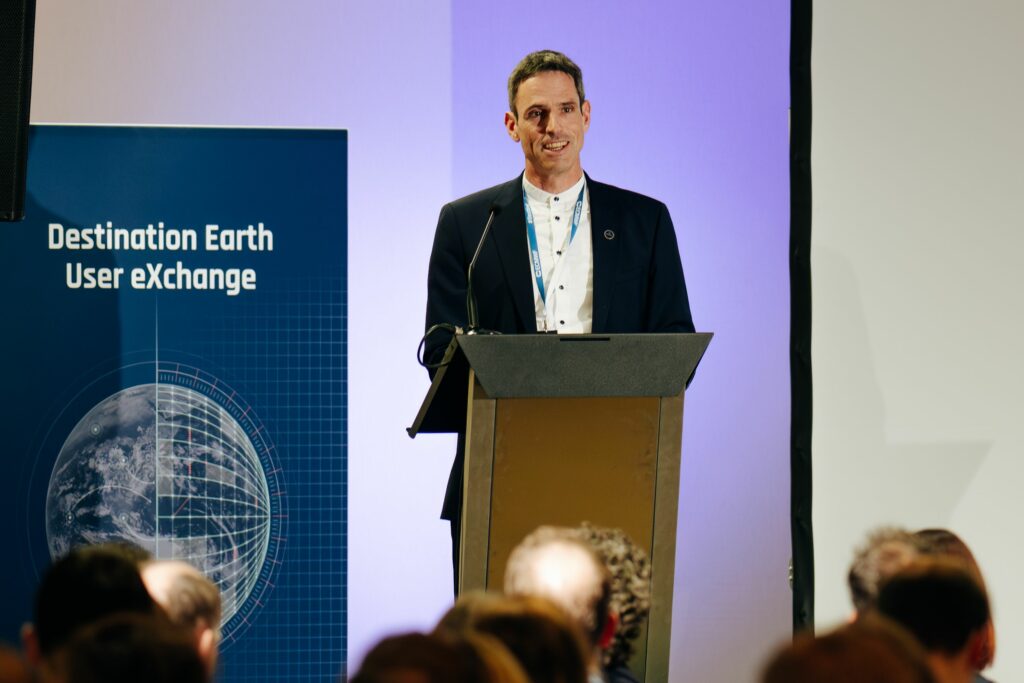
Jörn Hoffmann, DestinE Partnership Lead at ECMWF said: “It’s only the second User eXchange but we are very happy with how the community is coming together and growing. With our partners at ESA and EUMETSAT we conceive these meetings as a town square where the stakeholders in DestinE connect. In the end, the initiative must create real benefit to users. It will be crucial to understand users’ views and requirements and how DestinE can help address these. In that sense I think the meeting in Bonn was a success.”
Lively exchanges: a hugely popular poster session
37 poster entries from stakeholders and partners were presented at the end of the first day, prompting lively exchanges and large crowds. The ECMWF team for Destination Earth presented four posters introducing different aspects of the digital twins and the DTE.
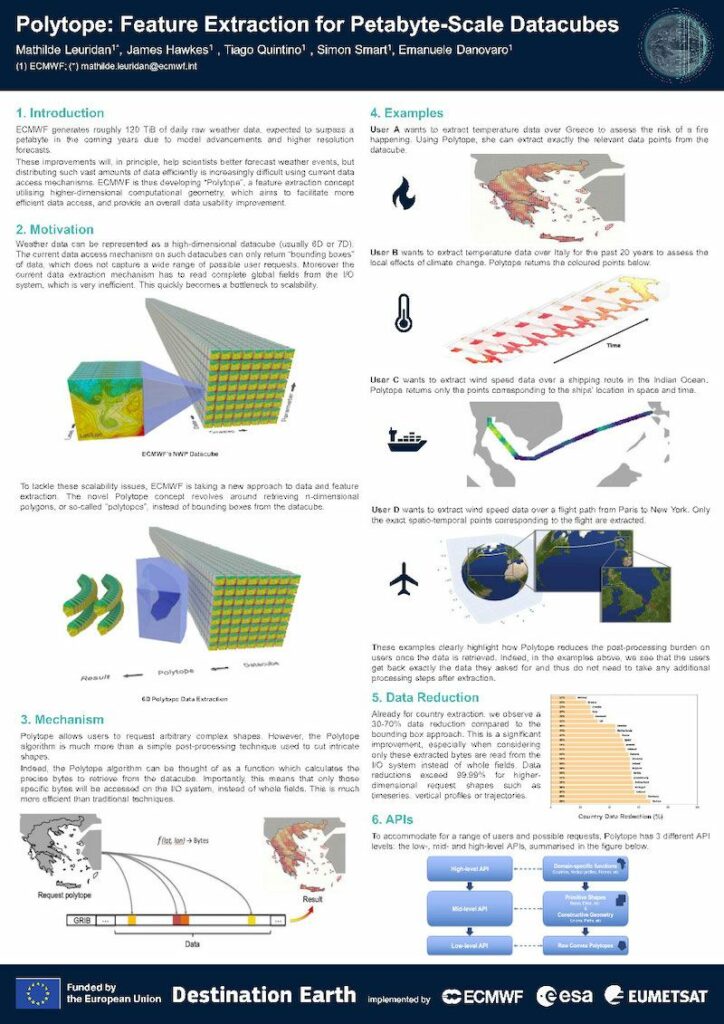
The Polytope software is a key component of the Digital Twin Engine. Designed to help distribute massive datasets produced by digital twins, it implements a novel feature extraction algorithm based on retrieving n-dimensional polygons, or so-called “polytopes”, instead of full data fields. This approach leads to both significant data and system I/O reductions, which will enable users to efficiently work with the large volume of data generated by the digital twins.
“This session was a great way to interact with future Polytope users. We were especially pleased to see the wide interest in the Digital Twin Engine and its individual components from our partners across Europe. I am now looking forward to incorporating the discussions that took place into the future of Polytope” said Mathilde Leuridan, presenting the poster in Bonn.
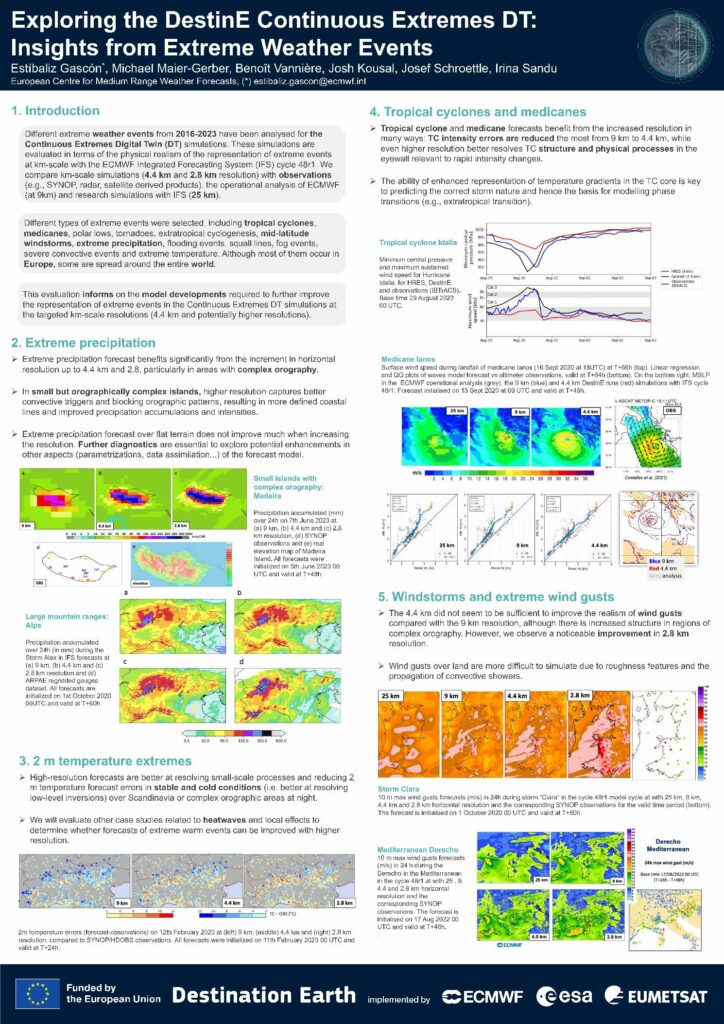
Scientist at ECMWF Benoît Vannière explained the poster “Exploring the DestinE Continuous Extremes DT: Insights from Extreme Weather Events” which unveils some of the progress made during the first tests of the global Extremes DT at horizontal resolutions up to 2.8 km. The first analyses of extreme weather events reveal noticeable improvements representing precipitation in complex orographic areas, as well as windstorms and extreme wind gusts.
“It was very exciting to see all the pieces of the puzzle together. I believe it’s the first time we had such a vision of how DestinE will be, even if only virtually, from the user’s request to the final result, because the different strands are now more defined. We had a glimpse of the enormous potential of the initiative.” said Vannière.
“The same potential user managing renewable energy in Croatia, expressed needs for the capabilities offered by the Extremes Weather DT, while simultaneously posing questions that are more suitably addressed by the Climate DT. This highlights the distinctiveness and the essential requirement for both DTs.” he added.
ECMWF scientists also presented MultIO and Plume, other bricks of the software architecture making the digital twins possible, that were presented previously during the European Geosciences Union meeting earlier this year.
See the MultIO poster
See the Plume poster
Many of the scientists involved in the initiative had the opportunity to attend the meeting and exchange views with colleagues that they usually only meet virtually, as well as meeting with the wider scientific and technology community.
Jasper Denissen, scientist at ECMWF involved in the implementation of hydrology in the Digital Twin said:
“This meeting is fantastic because most often we are immersed in our code, that we tend to focus only on our own work at ECMWF. In the User eXchange I met the people who actually will use it, as well as stakeholders and partners working in different aspects of the same field, and it has been interesting to learn about everyone’s progress and challenges. It has been a very inspiring experience.”
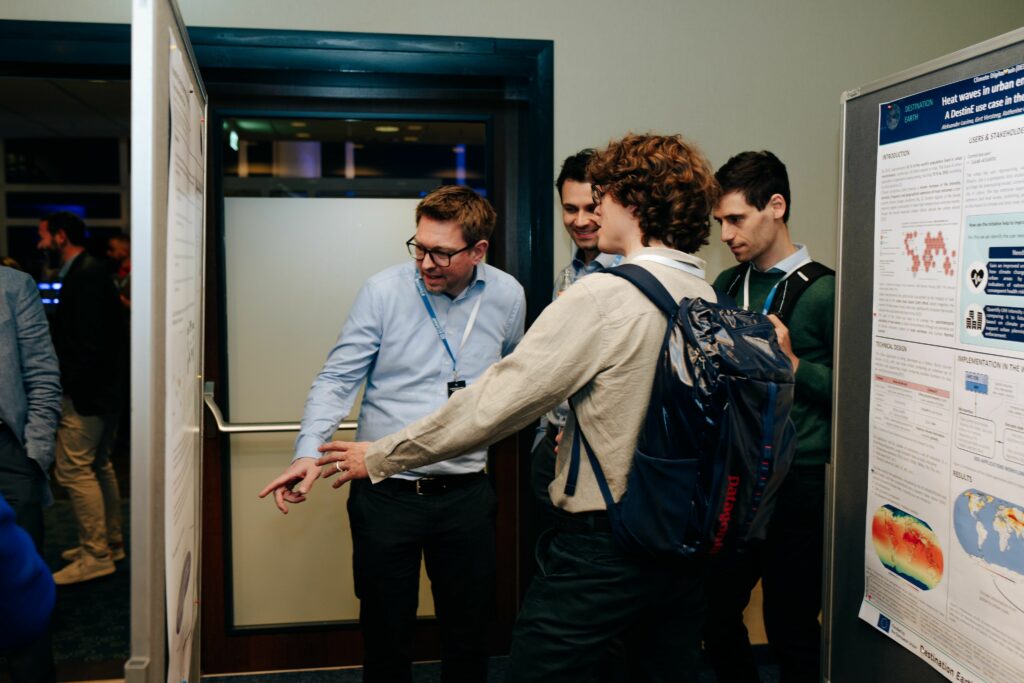
The poster session covered most of the aspects involved in Destination Earth. From the main components developed by ESA, ECMWF and EUMETSAT to Partnerships and Use cases.
Jacqueline le Moigne, Program Manager NASA, Advanced Information Systems Technology programme, presented a poster about the NASA Earth System Digital Twins Use Cases, and how they can enrich DestinE.
“My interest coming to the User eXchange is to see how we can co-ordinate with Destination Earth. Our first collaboration was on the use cases, to see how our use cases can complement each other, but also on the technology side, given that NASA has an open science policy, so everything that we develop is open source, and I think that most of what is developed for Destination Earth will be open source too, so we could benefit from each other and coordinate what we do.” said Jacqueline le Moigne.
“I saw that in one year there has been a lot of progress and I can see that something concrete is starting to emerge, and I think it’s very impressive.” she added.
All the posters are available on the DestinE website.
The next DestinE User eXchange details are yet to be confirmed but the door of the Community is always open via the DestinE website and the three entrusted entities.
Destination Earth is a European Union funded initiative launched in 2022, with the aim to build a digital replica of the Earth system by 2030. The initiative is being jointly implemented by three entrusted entities: the European Centre for Medium-Range Weather Forecasts (ECMWF) responsible for the creation of the first two ‘digital twins’ and the ‘Digital Twin Engine’, the European Space Agency (ESA) responsible for building the ‘Core Service Platform’, and the European Organisation for the Exploitation of Meteorological Satellites (EUMETSAT), responsible for the creation of the ‘Data Lake’.
More information about Destination Earth is on the Destination Earth website and the EU Commission website.

